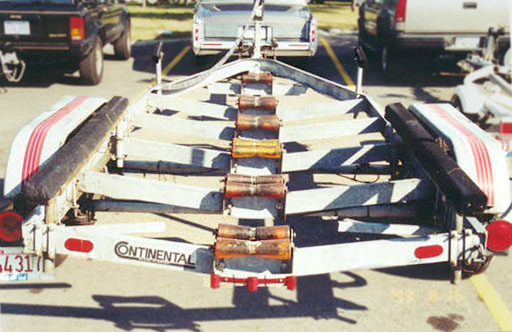
Fig. 1. This trailer has safely transported a Whaler 25 Outrage over 80,000 highway miles. The weight is born by the keel rollers. The carpeted bunks only provide lateral stability. Photo credit: Larry Goltz
A very high percentage of Boston Whaler boats are trailerable boats, and many Boston Whaler boats spend most of their lives sitting on trailers and being towed back and forth to the water. The most fundamental part of trailering is the trailer, and the most important part of the trailer is rigging it properly to accommodate a Boston Whaler. The unique construction of the Boston Whaler hull requires very specific trailer arrangements. The keel is the strongest area of the hull, and it should always bear most of the weight of the boat when on a trailer.
Until c.2000, the trailer was almost always a dealer-added item, that is, the trailer was not provided by the Boston Whaler factory but by the local dealer. Do not assume that because a boat is delivered on a trailer from a dealer that it is properly set up. More than an occasional boat has been delivered from a dealer with inappropriate trailer rigging. The dealer may have trailers on hand or marketing agreements with particular manufacturers which cause him to use a trailer that is less than optimum for your Boston Whaler boat.
The proper trailer for a Whaler is one with a combination of keel-rollers and bunks. Quoting directly from the first Whaler's Owner's Manual published in 1970:
"Padded bunks should be used instead of the roller cradle variety, as these may become misdirected and gouge or puncture the skin. The bunks should be adjusted so they just touch the hull, preventing it from rocking. Excessive weight on the bunks will make launching and loading difficult.
"Keel rollers must take most of the weight. They must bear on the keel--NOT adjacent hull surfaces, which may be damaged by full weight bearing on a narrow roller flange."
The Boston Whaler company also made these recommendations in some early literature:
Trailer Tips
Boston Whaler boats do not require special trailers, but selection should be based on the following important considerations:
- Approximate Trailer Load Ratings
- 13-footer: 600-lbs
- 16-footer: 1,200 to 1,600-lbs
- 19-footer: 2,500-lbs
- 19-sterndrive: 3,000-lbs
- 21-footer: 3,000-lbs
- For long haul, use biggest tires available.
- Use wooden side supports—not rollers. Side rollers may become misdirectd and damage boat.
- Keel rollers must take nearly all the weight, bearing on keel, not adjacent hull surface.
- Winch stand should have bow stop above the bow eye. This allows winch to pull eye straight in, and provides security in a panic stop.
- Flat chassis type trailers are required for 19- and 21-foot models. Trailers designed for deep-V boats cause sponsons to rub on fenders.
Here is an example of an keel roller style trailer, with plenty of rollers:

Fig. 1. This trailer has safely transported a Whaler 25 Outrage over 80,000 highway miles. The weight is born by the keel rollers. The carpeted bunks only provide lateral stability. Photo credit: Larry Goltz
And here is an example of an all-roller style trailer, a configuration definitely not recommended for Boston Whaler boats:
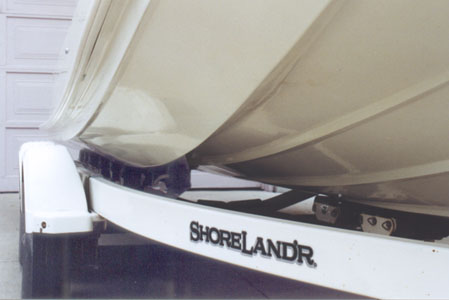
Fig. 2. All Roller Trailer. Although the mid-center of this Revenge 21 hull rests on a keel roller, the stern sponsons are left to awkwardly bear on cradle rollers, and the eaviest portion of the boat, the transom and motor, is not supported at all. This is not a recommended style of trailer for Boston Whaler boats. Photo credit: JWH
Typically the rollers found on most trailers are constructed of hard rubber with a plastic end insert or sleeve which acts as the bearing for the steel axle shaft which mounts the roller. A drawback of these rollers is that they tend to deform under load, which greatly increases the friction of their rolling, making it harder to get the boat on or off the trailer. Also, they soften with age and shed rubber onto the boat hull, producing long black streaks on the hull as the boat rolls across them. They also tend to deteriorate, eventually splitting, leaving the steel center pin exposed to damage your hull.
An alternative are the poly-rollers made initiallyy by the Stoltz company but now widely duplicated and available from many sources. These amber colored rollers are available in many shapes and sizes to replace most any existing rubber roller. They offer virtually no deforming under load, longer life, and much less marking of the hull, particularly compared to old rubber rollers. They will generally permit easier launching and recovery because of their reduced friction in rolling with the load of the boat on them. Of course, they are about three times the cost of the rubber ones they replace, but many feel they are worth the extra expense to avoid marking the hull and to provide longer, more trouble-free use.
When replacing existing rollers with Stoltz rollers, there is a potential for a corrosion problem to occur. The typical rubber roller has plastic inserts that mount the roller to the steel axle passing through its center. The Stoltz roller has a steel center sleeve. The typical axle used on most trailers is also steel, and it is possible for rust to bind the two together, preventing the roller from performing its intended function of rolling!
The solution is to also upgrade the steel pins to stainless steel. A well greased stainless steel roller pin will provide long-term freedom from corrosion, even in salt water use. The pins are available for approximately $5-$10 each, but distribution of them is limited to just a few outlets. One source is Champion Trailers. The stainless steel pins are drilled to accept cotter pins, which provides a more secure retainer than those end caps used on the plain steel pins.
Larry Goltz has over 100,000 miles of experience and success trailering a Boston Whaler on a keel-roller-and-bunk style trailer. He recommends this technique for setting up the bunks on a keel roller trailer:
"First launch your boat. With the boat off the trailer, drop the trailer's bunks down so they won't even touch the boat. Then check the alignment of the keel rollers. Sight the length of the straight section of your hull, then stretch a string over those rollers to make sure they all line up. The rollers where the hull starts to curve up to the bow are harder to adjust properly and involve some guess work.
"Then retrieve the boat, winching it all the way up on the keel rollers. It will rock or lean over a little, but don't worry about it. You may want to re-adjust your winch stand and bow stop at this time. [More on this below.] Then, snug your bunks up to the underside of the hull, as far out as possible, leveling the boat on the trailer, and tighten them to resistance, but not locking the bunks in place. Next, using a hammer, pound the supports upward on one side really snug against the hull and then fully tighten their retaining bolts. Then, put someone in the boat standing over the bunk you just tightened. Crank down the transom strap on that side, and then do the same on the other side's transom strap.
"This will give you a really tight, rock-free installation, but all the weight will still be on the keel rollers. After a while, as the boat settles on to the bunks and compresses the carpeting, you will have to re-adjust the bunks again, using same method. This method works very well with any size Whaler, and you will be assured all the weight is on the keel."
When properly set up, a keel roller trailer is very easy to load. Avoid the tendency to immerse the trailer too far into the water. Typically only the rear-most set of rollers will be under water. Once you have found the proper position for best loading, place a mark (a piece of tape) on the trailer fender on the driver's side. Use this mark as a depth gauge when backing the trailer down the ramp.
Here is an example of a keel roller trailer in proper position on the ramp for loading:
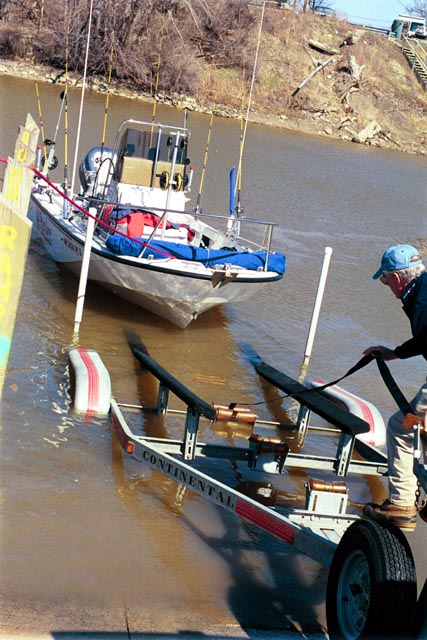
Fig. 3. Loading a Keel Roller Trailer. Jim Gibson has positioned his Continental keel-roller flat-frame trailer on the ramp so that the only two rear sets of rollers underwater. Tall side guides will help align the boat as it is winched onto the trailer. These are a great help in getting the boat centered on the trailer. Attaching the winch strap to the bow eye while balancing on the trailer requires some agility if you want to avoid wading into the water a few feet. With the rollers taking most all of the load the boat will winch onto the trailer with ease, and it will self align to center in the process. Note that the rear rollers are 12-inch wide and set in pairs. The front rollers are slightly smaller, but also paired. The single roller at the bow is very important. It keeps the bow of the boat from dropping when unloading, and this keeps the bow eye from being hung up on the winch bracket's roller. Photo credit: JWH
In the past decade or so, a new style of trailer has evolved, which consists of only bunks and no rollers at all. In some of these designs there may be a single vestigial keel roller at the stern end of the trailer that serves only to deflect the boat upward onto the bunks when loading and then, with the boat fully on the trailer, that roller does not even contact the hull. Or there may be a couple of small rollers at the bow, needed because bunks cannot support that area because of the upward curving shape of most hulls. In these trailers the much of the weight of the boat is carried by the bunks, except that often the bunks provide little support for the transom area where the greatest weight of the entire boat--the outboard engine--is often left unsupported. The hull is frequently left to function as a cantilever to hold up the transom, placing quite a bit of stress on it. These trailers are generally constructed to carry the boat hull quite low on the trailer and are called "float-on" trailers, the name indicating the retrieval technique where the low profile trailer is almost completely submerged and the boat is floated on to the trailer. There is little or no winching of the boat up the trailer anticipated, as there would be considerable friction between the boat and the four or more carpeted bunks which support it. These trailers have become very popular and represent a sizeable segment of what is offered for sale in the current trailer market.
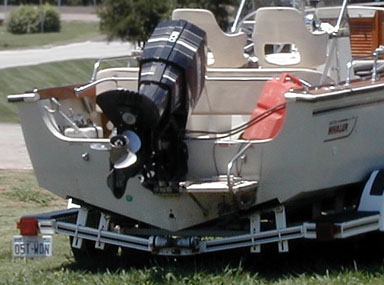
All the previous statements by the factory urging use of keel rollers notwithstanding, the current thinking at Boston Whaler is that using a float-on bunk trailer is acceptable as long as the hull is well supported by multiple bunks. In certain packaged combinations of boat/motor/trailer, the Whaler factory delivers new boats in this style trailer. In 2001, it is anticipated that the packaging of boat, motor, and trailer will become more extensive in the Boston Whaler line-up, so it is likely you will see more and more of the bunk style, float-on trailers under Boston Whalers.
Many dealers have been routinely putting new Boston Whalers on trailers like this for some time, in part because that is the easiest trailer to find on the market. It seems like practically none of the manufacturers with widely distributed lines of trailers, E-Z Loader and Shorelandr for example, have current designs which can be configured to use both keel rollers (for load carrying) and bunks (for stability only). The float-on style trailers are often constructed with a very limited number of cross-members, sometimes only one or two, and have literally no place to put any keel rollers. You also have to wonder about the rigidity of such a trailer where the side rails of the trailer are only connected by one or two cross-members.
What is the advantage of this style trailer? The name "float-on" conveys most of the perceived benefit, that is, you won't have to winch the boat up the trailer. Certainly with a long, heavy boat and a manual winch, cranking the boat up the trailer could be a tedious task. And, compared to the floppy cradle roller style trailer, the float-on bunk is much simpler mechanically--it has no moving parts-- and is also much easier (and cheaper) to fabricate.
The disadvantage of using the float-on bunk trailer is the need to back the trailer down the ramp until its bunks are submerged below the boat. Depending on the ramp, this may or may not be achievable with your tow vehicle remaining on dry pavement. If your trailer boating is being done in tidal areas, launching from some ramps may need the benefit of high tide to create enough depth to submerge the trailer. In general, the float-on trailer probably requires a deeper ramp than the keel roller trailer would to launch and recover the same size boat. To overcome this, these trailers are often made longer with several extra feet of trailer between the hitch and the winch in order to allow the trailer to be backed farther into the water and still keep the tow vehicle on dry land. The extra length does not do much for the trailer in the parking lot or storage area where extra length may mean extra charges.
Also endemic with these trailers is a tendency to want to "power load", that is, to use the boat's engine to propel the boat forward and upward onto the trailer which has not been submerged sufficiently to permit the true "float-on" style of loading. At many, many, ramps the practice of "Power-Loading" is expressly prohibited, although it is frequently done in violation of the posted rules. It seems the owners of this style trailer have been sold the principal of "no cranking the winch" and they are bound to abide by it, even if it requires 200 HP to push the boat up the bunks. You have to wonder why such force is needed to load a trailer that is supposed to be "float-on" loading.
Because most ramps descend into the water at an angle, when the trailer is submerged completely, the rear of the trailer is much deeper than the bow end. This gives rise to two scenarios. When the ramp is deep and permits sufficient immersion of the trailer, it is common to see loading by floating the boat right to the winch bow stop, securing the bow eye to the winch strap, then driving the tow vehicle forward until the stern of the boat drops onto the bunks. Frequently the stern of the boat does not fall centered on the trailer and the process must be repeated several times to get the boat aligned properly. To assist in centering the stern, many of the float-on style trailers add side railings which attempt to confine the boat to a limited amount of side-to-side swing in the stern as the trailer comes up under it.
The alternative approach, which probably evolves after boaters tire of the trail-and-error full float-on technique, is to only partially submerge the trailer, float the boat on until the forward portion contacts the bunks, then drive or winch the boat the remaining length up the wet bunks. Helping out in this situation is the fact that most boats have considerably more draft in the stern than the bow, so the boat may tend to contact the bunks somewhat uniformly.
If you ponder it for a moment, to truly have a "float-on" trailer in which the boat uniformly settled into the bunks, the trailer and bunks would have to be raised quite a bit in the stern to compensate for the descending slope of the ramp. Of course, this would be a ridiculous way to tow the boat on the highway, and it is never done. Instead, the boat is loaded by floating only about half way up the bunks, and the rest of the distance the boat must by dragged (by winch) or pushed (by the motor) up the bunks to the fully loaded position. At this point the task is harder because there are not rollers but just wet carpeted bunks supporting the weight of the boat.
With the boat on the trailer, the low-profile nature of the rig puts the keel of the boat quite low to the pavement. This has two disadvantages. First, ground clearance to highway obstructions is reduced, exposing the hull and keel to more potential damage from road hazards. Second, the low mounting almost always means the boat must be transported with the motor fully tilted up. Actually, better to remember to tilt it up before you haul it up the ramp, as ground clearance to the skeg is often frightfully small. In any case, cruising down the highway will necessitate having the motor tilted up, which greatly increases the tendency for it to rock and work on the transom. To offset this, it is now common practice to rig a supporting strut from the trailer to the outboard's skeg in order to stabilize and support the considerable cantilevered weight.
Taken in total, the float-on bunk style trailer does not seem to offer any great advantage. The one thing, however, that is definitely easier with this style is locating one in the marketplace. They are popular, particularly with certain styles of boats, but they are not perhaps the best choice for a classic Boston Whaler.
It has been 13 years since I wrote this article, and I have some new perspectives toward trailers and Boston Whaler boats. First of all, it is clear that there is not an imperative to have an all-keel-roller trailer. Boston Whaler has been delivering its boats with factory rigged trailers without using the all-keel-roller design for about two decades. Trailer manufacturing has gone away from providing lots of keel roller trailers, and it is very hard to find a trailer with OEM keel rollers or even one you could fit keel rollers to yourself.
What I see now in trailer design is a hybrid trailer, that uses bunks to support a lot of the boat weight in the aft half of the boat, and keel rollers to support the boat weight in the forward half of the boat. In actual use these trailers launch and load much like an all-keel-roller trailer due to the buoyancy imparted by water. When you back the trailer into the water, the stern of the boat submerges and creates buoyancy, lifting much of the weight of the boat off the bunks. This same effect occurs in loading. The keel rollers in the forward part of the trailer take up the load as the boat tries to pitch down by the bow. Launching and loading using a trailer with stern bunks and foward keep rollers is very easy. Loading does not require a lot of effort on the winch. Launching generally results in the boat coming off the trailer with ease--sometimes with great ease, so be ready for it.
Ultimately the boat and trailer must be arranged in such a way that a certain balance is created between the weight born by the trailer's axle(s) and the weight that remains to be supported at the tongue. The force with which the trailer tongue bears down on the hitch of the towing vehicle is known as the tongue weight, and its adjustment is important.
To provide good behavior from the trailer while towing at highway speeds, it is generally recommended that about 7% to 15 % of the total weight of the trailer load be distributed to the tongue. Making the tongue weight too heavy has obvious disadvantages for the tow vehicle. Its rear end will sag, the front end will tend to rise, and, if carried to extremes, the weight on the tow vehicle's front tires may be reduced to dangerous levels that could cause problems in steering.
A tongue weight that is too light also has potential for problems. The most likely of these is a tendency for the trailer to fish-tail down the highway. An oscillating trailer is a very uncomfortable and dangerous thing to tow. By keeping the tongue weight in the recommended range you can avoid these problems.
Although the "recommended" tongue weight is always quoted as 7% - 15% of the total weight, there are situations in which towing with a slightly lighter tongue weight ratio has proven successful. It is believed that the higher ratios of tongue weight usually cited are most applicable to towed vehicles like travel trailers, which tend to have much greater wind load area than a boat and also a higher center of gravity. Boat trailers tend to have lower center of gravity and to have less wind loading, and thus they may be less affected by buffeting from side winds. Also, the weight distribution of a boat trailer, with most weight concentrated mainly in the stern, tends to place the axles farther aft than would occur with a travel trailer, where they tend to be more centrally positioned.
The axle on a boat trailer is generally located asymmetrically with respect to the fore-and-aft length of the boat, and it is almost always behind the fore-and-aft mid-point of the boat. Because the surface area of the boat tends to be more uniformly distributed with respect to fore-and-aft location, the lateral forces from side winds will tend to be symmetrical about the fore-and-aft mid-point. Hence, the center of effort of side winds will be applied forward of the axle. Thus both the trailer's tires and the trailer's tongue resist the lateral push from the cross winds.
Another consideration is the center of gravity (CG) of the rig. With tall, boxy travel trailers, the CG is probably much higher than with a boat. This means that side winds hitting a travel trailer can have more leverage on leaning the trailer to one side. Any such lean reduces the weight bearing on the tires on one side, and that reduces the traction of those tires, making them less resistant to sway. With a boat, the center of gravity is likely to be lower, and thus side winds will not have as great a tendency to induce lean in the trailer. The tire traction will remain more constant and sway will be reduced.
Trailers with multiple axles also tend to be more sway resistant. They have more tires and thus more tire surface on the road, increasing resistance to sideways motion or sway.
Thus, in the case of towing boats with a high percentage of their weight in the stern and with multiple axles located well behind the fore-and-aft mid-point of the boat, it may be safe to rig the boat for tongue weights lower than the "recommended" 7% minimum. In my own experience I have had success towing with about 5% tongue weight in these circumstances.
Tongue weight is determined by the position of the boat on the trailer relative to the trailer axle(s). But moving the boat relative to the trailer is not the way to adjust this!.
The best trailers provide independent adjustment of the position of the trailer axles relative to the trailer frame. This is an important advantage. The trailer frame can be fitted to the boat for best support, then the trailer axle(s) can be moved along the frame to permit adjustment of tongue weight to the desired amount.
In adjusting the boat to the trailer, it is best to move the boat onto the trailer so that the transom of the boat lies exactly over the last keel roller on the trailer. This provides the heaviest part of the boat with the greatest support. Boats are often seen rigged on trailers where the transom and engine are cantilevered several feet beyond the last keel roller or bunk support from the trailer. The greatest weight on all the boat is left unsupported by the trailer, causing the boat hull to take up this load bearing role.
The better trailers do not attach their axles directly to the trailer frame, but instead provide an intermediate carriage assembly. The axles and springs attach to the carriage assembly, which can then be moved en toto along the trailer frame in order to locate the axle(s) at the desired point for best balance and tongue weight.
As boat manufacturing becomes more vertically integrated, it is becoming common these days to find boats sold in packages not only with factory-rigged motors but with factory-rigged trailers as well. In some cases these trailers are custom fabricated for the boat and all the elements of the trailer--its rollers, bunks and axles--are pre-configured and welded into place. In these cases you must just hope the boat builder and trailer builder worked in concert and got it right. Another consideration with such a trailer is its limited utility with any other boat. If you decide someday to upgrade your trailer, your existing all welded construction trailer will have a very limited market into which you can try to sell it since it only fits one boat. Trailers with more adjustable elements can be adapted to a wide variety of different hulls should you decide to sell the trailer.
When buying a trailer, give extra consideration to the axle position adjustment. Not many trailers provide a convenient means of moving their axles, and adjustment may be quite tedious. If an after market trailer has no means of moving the axle position, you will have to resort to moving the boat relative to the trailer to arrive at proper tongue weight. This may not always produce the best location for the boat on the trailer.
If adjustment is made to the axle position on a trailer, be certain that the axle remains square to the trailer center line. Out-of-alignment axles cause uneven tire wear and produce poor ride characteristics. It is also prudent to check the axle for vertical alignment as well. If the axle is not parallel to level ground, tire wear will suffer.
To understand more about the forces involved in controlling and adjusting trailer tongue weight, see Jerry Townsend's excellent analysis.
The location of the winch stand should be adjusted so that the winch stand's bow-stop is located above the boat's bow-eye. There are two benefits to this:
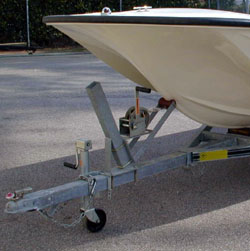 |
Fig. 5. Winch Set Up The bow stop is positioned just above the bow eye (hidden). The winch line pulls level into the reel. The bow stop provides a mechanical stop preventing the boat from moving upward and forward in a panic stop. Photo credit: Jonathan Fabri |
To protect the rub rail from damage, Whaler recommended using wooden tie down blocks, as shown below. Also, the straps should not be run diagonally across the boat.
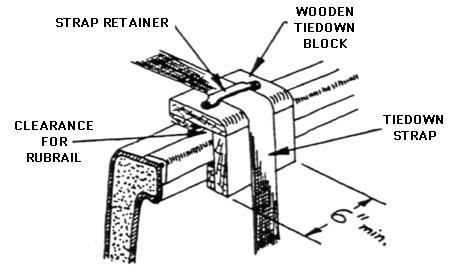 |
|
Wooden Tie down Blocks Whaler recommends protecting the rub rails from damage with wooden blocks, fabricated as shown. Photo credit: BW Owner's Manual, 1970 |
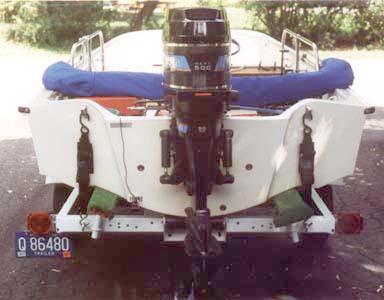 |
Transom Tie downs Tie downs can also be secured to the ski eyes on the transom and run to eyebolts on the trailer. Be sure to prevent any metal parts from banging against the gel coat. Photo credit: JWH |
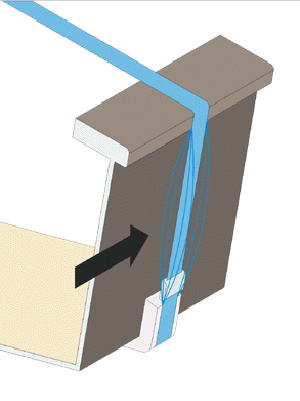 |
Tie downs A tie down that run across the width of the boat is another effective way to secure the hull to the trailer, with the advantage that it can be observed from the tow vehicle while on the road. But wind can set the strap vibrating, producing slapping against the hull with enough force to abrade gel coat or bottom paint. Dwg by: Walt Steffens |
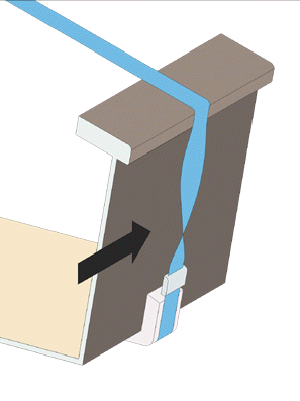 |
Tie downs with a Twist Walt Steffens has a better idea: by adding one half revolution of twist to each side of the tie down, you can suppress the tendency for it to vibrate in the wind. Dwg by: Walt Steffens |
DISCLAIMER: This information is believed to be accurate but there is no guarantee. We do our best!
Copyright © 1999, 2000, 2018 by James W. Hebert. Do not reproduce without permision.
This article first appeared May 14, 2000. This is a verified HTML 4.0 document served to you from continuousWave
Author: James W. Hebert